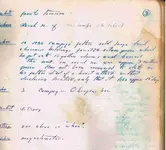Hola amigos,
For our readers to consider, <
I realize that some of our friends here have very strong convictions against the whole proposition of Jesuit treasures and/or mines, so no offense to you - just adding more to the pot for the rest, those still un-decided> we have yet more testimony on the Jesuits mining activities in what is now Arizona.
Arizona is at once the oldest and youngest mining territory of the United States. Three hundred years ago before St Augustine Florida was settled the Jesuit fathers established the cross in the wilds of Arizona. They found as the antiquarian and archaeologist of to day may find ruins of pre historic houses pottery acequias or irrigating canals cave dwellings and evidences that a former civilization had there lived flourished and disappeared. The country then was as it continued for three centuries to be the home of the treacherous and cruel Apaches who waged an unrelenting warfare upon all who sought to acquire the rich mineral treasures confided to their care. Spanish records and traditions reveal the fact that the Jesuits mined the silver lodes of Arizona at intervals with good results though in their usual rude and indecisive manner.
<from
The Bankers' magazine, and statistical register, Volume 32 Arizona and Silver Mining, George R Gibson April 1878 pp 813>
Considering that the Jesuit explorations of the northern frontiers reported a number of mineral discoveries, what could have "triggered" their keeping the same kind of discoveries and mines secret?
Most Arizona historians are familiar with the great discovery of silver, the "planchas de plata" which occurred in 1726,<or 1736, depending on source> resulting in a minor "silver rush" to the area of southern Arizona. Whom made this discovery? Here is what Hinton has to say
surprising spot a depth of a few varas masses of pure silver were found of a globular form and of one or two arrobas in weight. Several pieces were taken out weighing upward of twenty arrobas and one found by an inferior person attached to the Government of Guadalajara weighed 140 arrobas. Many persons amassed large sums whilst others though diligent and persevering found little or nothing For the security of this mass of treasure the commander of the Presidio of Altar sent troops who escorted the greater bulk of the silver to his headquarters whereupon this officer seized the treasure as being the property of the Crown. In vain the finders protested against this treat ment and appealed to the audience chamber at Guadalajara but for answer the authorities referred the matter to the Court at Madrid. At the end of seven years the king made the decision which was that the silver pertained to his royal patrimony and ordered that thenceforth the mines should be worked for his benefit. This decree together with the incessant attacks of the hostile Indians so discouraged the treasure hunters that the mines were abandoned as needs must be until these savages are exterminated.
Not all the priestly historians write so smoothly of this transaction which by the way is commented on in every work upon Mexican mines since written and published. The reader who should desire to see how deep in gall a Castilian may dip his pen on the same subject should peruse a work entitled Los Ocios Espanoles or the documents yet existing in the archives of Pimeria Alta written by Jesuit Fathers who were despoiled by this act of the King Curses loud strong and binding were showered upon the royal robber and thenceforth such discoveries were most carefully locked up in the breasts of the Fathers until at last the cream had been properly skimmed off This was the real beginning toward uncovering
<The Handbook to Arizona; its resources, history, towns, mines, ruins and ...By Richard Josiah Hinton, PAYOT UPHAM & CO SAN FRANCISCO AMERICAN NEWS CO NEW YORK 1878 , pp 195>
Hinton gets the date of the discovery wrong, but this is fairly common as few history books agree on the correct date. It makes sense that the Jesuits would be angry over the silver discovery being taken away from them, either by Spanish colonists or the authorities, and would explain why they would keep any other discoveries they intended to exploit,
quiet. I also put the title of the work in bold to bring it to our readers attention, for perhaps someone may have access to this very manuscript? The title means 'The Idle Spanish' (my own rough translation, I welcome any corrections) and unfortunately there are a couple of Spanish-language publications with titles like it, but slightly different.
Wishing you all happy holidays,

Oroblanco






 I very much look forward to meeting some time, and hopefully sooner rather than later.
I very much look forward to meeting some time, and hopefully sooner rather than later. 


 .
.





